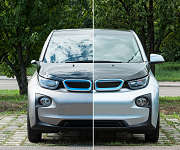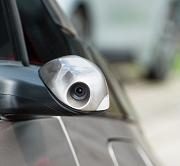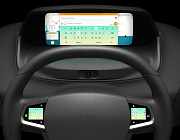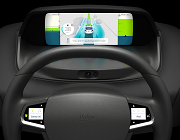Valeo’s Intuitive Driving = Autonomous Driving + Connected Car + HMI: a Q&A with Amine Taleb
Editor’s note: This is another in DT’s series of Q&As with leaders in the automated, connected, and driverless vehicle industry.
 Dr. Amine Taleb is the manager of advanced projects for Valeo’s Comfort and Driving Assistance (CDA) Business Group in North America, where he leads the advanced engineering in Advanced Driver Assistance Systems (ADAS) applications. He has more than 20 years’ experience in advanced technologies with technical expertise in the opto-electronic field. Dr. Taleb graduated from the University of Michigan with a doctorate in Physical Chemistry.
Dr. Amine Taleb is the manager of advanced projects for Valeo’s Comfort and Driving Assistance (CDA) Business Group in North America, where he leads the advanced engineering in Advanced Driver Assistance Systems (ADAS) applications. He has more than 20 years’ experience in advanced technologies with technical expertise in the opto-electronic field. Dr. Taleb graduated from the University of Michigan with a doctorate in Physical Chemistry.
Valeo is an automotive supplier dedicated to the reduction of CO2 emissions and to the development of intuitive driving. In 2014, the company generated sales of $16.7 billion. It has 133 production sites, 50 research and development centers and 15 distribution platforms in 29 countries.
Sustainability is a major goal for Valeo. How do you incorporate sustainability in your development of autonomous technology?
Research and development plays a fundamental role in such a goal, by innovating in areas that lead to greener and more efficient mobility. This is why Valeo is focusing its efforts on developing solutions for the reduction of CO2 emissions and pioneering “Intuitive Driving,” which includes autonomous driving as one of its three pillars. The two other pillars are connected car and advanced human-machine interface (HMI). To accomplish this, recruiting the best talent and building a solid expertise foundation are key. In addition, listening to the consumer and partnering with technology leaders, who share common principles, are key towards these goals.
 Valeo in December purchased the German firm peiker, known for its expertise in mobile communications technology. How will this help Valeo as countries build V2V and V2I communications?
Valeo in December purchased the German firm peiker, known for its expertise in mobile communications technology. How will this help Valeo as countries build V2V and V2I communications?
The acquisition of peiker is another step on our journey towards the connected car. Peiker is a market leader in automotive telematics connectivity solutions, and coupled with our on-board electronic know-how, it will help us develop innovative vehicle connectivity and telematics solutions. One of the examples in connectivity is V2X, which is gaining more and more traction worldwide, with the U.S. leading the V2V efforts for safety applications. We see V2X as a key element towards the connected and automated car, and also towards smarter mobility. This is very much in line with our vision of Intuitive Driving.
In November you partnered with Capgemini to offer mobility for corporate fleets and car rental firms. Where is this available? How does it work?
Valeo InBlue technology is a vehicle smart-key access system using smartphone technology. One feature is secure virtual key sharing suited for various car-sharing models. Capgemini has an expertise in digital solutions and IT integration that will enable the development of customizable mobility solutions with applications for corporate fleets and car rental.
The InBlue mobility solution will be tested out on a smaller scale with Parcours, a French leasing services company. InBlue is packed with an extensive suite of tools such as vehicle access and start, geo-localization, remote vehicle data access, etc., which will benefit end-users and fleet administrators.
You showcased a number of forward-thinking products at CES 2016. Your Sightstream camera system is designed to replace rear view mirrors. How does Sightstream work? Can this be sold in the U.S. where vehicles must have rear view mirrors? What clients are using the technology?
 The Valeo Sightstream camera system relies on the combination of high resolution camera and display to fulfill, to a minimum, the visibility requirements of conventional exterior mirrors. The exterior mounted camera projects the captured rear view scene onto the display located in the interior of the car. Innovations that improve vehicle aerodynamics are one of the keys to achieving the U.S. regulatory fuel efficiency target of 54.5 mpg by 2025. Sightstream enables automakers to improve aerodynamic drag by five percent which improves overall vehicle fuel economy.
The Valeo Sightstream camera system relies on the combination of high resolution camera and display to fulfill, to a minimum, the visibility requirements of conventional exterior mirrors. The exterior mounted camera projects the captured rear view scene onto the display located in the interior of the car. Innovations that improve vehicle aerodynamics are one of the keys to achieving the U.S. regulatory fuel efficiency target of 54.5 mpg by 2025. Sightstream enables automakers to improve aerodynamic drag by five percent which improves overall vehicle fuel economy.
Compared to conventional exterior mirrors, Sightstream also provides an enhanced visibility based on its wider field of view, which can potentially lead to the elimination of the blind spot. Other advantages are improved visibility in daytime, nighttime, and even in adverse weather driving. This technology may also increase driver situational awareness when other advanced safety sensors are added.
Rearview mirrors are federally regulated safety devices so any updates to the standards are necessary to allow such technology on the road. The Sightstream camera system utilizes mature technologies already in production. Because of the benefits I have highlighted, and with the maturity of these key components, it is just a matter of time before we would see camera monitoring systems in production cars, potentially as early as 2017 in Europe.
Cruise4U manages steering, accelerating and braking, and it allows drivers to switch between manual and autonomous control. What clients are using this, and when will it be available?
Valeo Cruise4U is a demonstration vehicle that highlights the simple integration of two unique ADAS sensors, namely front camera and Scala laser scanner, which are key building blocks for the sensor fusion architecture of Level 2 and higher automated driving. Both of these sensors are production intent technologies with the Scala to be launched by a major OEM in early 2017. While I am not at liberty to discuss details of any ongoing collaboration we might have with any carmaker, we are a key partner to major OEMs in the development of automated parking and automated driving solutions.
Scala was developed with Ibeo, Mobileye, and IAV. What is Valeo’s approach to partnering with other tech providers?
The Valeo Scala laser scanner provides unique features such as its wide field of view, detection range, high precision in object detection and tracking while driving up to highway speeds. Also, objects in its field of view, moving or not, are classified, thus enabling a precise path planning and maneuver.
The Scala was developed for automotive high-volume OEM applications through our exclusive partnership with Ibeo, a leader in high-tech laser scanner technology for automotive applications. In addition, the front camera, such as the one used on Cruise4U, will take advantage of Mobileye’s EyeQ chip vision technology.
By partnering with IAV, an engineering firm and vehicle integrator, we were able to integrate these advanced sensors in our Cruise4U.
In a very fast moving market, strategic partnerships with world leading companies are essential to effectively build up cutting edge capabilities necessary for autonomous driving technologies.
Your Mobius 2 product also allows for switching from manual to autonomous driving. With Mobius 2 the driver can interact with their tablet or smartphone while in autonomous mode. Is the world ready for this much distraction?
 One of the benefits of automated driving is not only to provide safe driving, but also to eliminate the driving boredom of being stuck in a slow-moving traffic or mundane long distance highway driving. Mobius enhances the user experience, while keeping safety in mind. By mirroring the smart device to the instrument cluster during autopilot mode, the driver is able to interact with it using the reconfigurable steering wheel switches. That ensures the driver’s eyes are in the direction of the road and his hands are in proximity of the steering wheel. That allows for a very quick takeover, if requested by the vehicle. That is important, particularly for Level 3 automation.
One of the benefits of automated driving is not only to provide safe driving, but also to eliminate the driving boredom of being stuck in a slow-moving traffic or mundane long distance highway driving. Mobius enhances the user experience, while keeping safety in mind. By mirroring the smart device to the instrument cluster during autopilot mode, the driver is able to interact with it using the reconfigurable steering wheel switches. That ensures the driver’s eyes are in the direction of the road and his hands are in proximity of the steering wheel. That allows for a very quick takeover, if requested by the vehicle. That is important, particularly for Level 3 automation.
The Valeo Mobius was tested on a simulator at the Fraunhofer Institute in Germany. Test drivers’ takeover time was measured while interacting with the smart device via the Mobius, versus holding the smart device in their hands while the car was in autopilot. The results have clearly shown that takeover via the Mobius was 500 milliseconds faster than when holding the device in their hands. This could mean life or death at highway speed.
Mobius 2 has a camera monitoring the driver for signs of distraction and fatigue. Has there been pushback from clients/consumers on technology that watches the driver?
 The Mobius cockpit concept was subjected to tests by more than 60 end-users during worldwide clinics last year. We have not heard or felt pushback by any of them for having the camera monitoring their distraction or signs of fatigue. On the contrary, and especially in the takeover transition phase from automated to manual, end-users expected to be monitored and validated as capable to take back control of the car. The benefit seen by the driver exceeded the perceived annoyance of being monitored. In our findings, driver monitoring was found to be necessary for the increased trust in automated driving.
The Mobius cockpit concept was subjected to tests by more than 60 end-users during worldwide clinics last year. We have not heard or felt pushback by any of them for having the camera monitoring their distraction or signs of fatigue. On the contrary, and especially in the takeover transition phase from automated to manual, end-users expected to be monitored and validated as capable to take back control of the car. The benefit seen by the driver exceeded the perceived annoyance of being monitored. In our findings, driver monitoring was found to be necessary for the increased trust in automated driving.
Moreover, if we focus on safety benefits of a driver-monitoring camera, in addition to other types of monitoring sensors such as steering wheel sensing in the Mobius, I believe these have an enormous advantage in protecting the driver from being distracted by smartphone and tablet usage while driving in manual mode. Every car should be equipped with such technologies to ensure the “eyes on the road” and “hands on the wheel,” and deter the crashes and fatalities caused by such distractions.
How do you break down doors at auto OEMs that aren’t using your driverless technology?
With our global footprint, and innovation in our DNA, our goal is to be partners with all the major OEMs, as well as emerging ones, in accomplishing autonomous driving. While each OEM might have different strategy towards automated driving, our innovation roadmap allows us to adapt our functions and products for each customer. The Scala is a good example of our strategy as it is the first automotive-grade laser scanner, soon to be on the market for automated driving.
To summarize, the car of tomorrow should be safer, cleaner, and more intelligent, and driving should be more fun and enjoyable. That’s our Intuitive Driving approach.
Thanks Amine.
